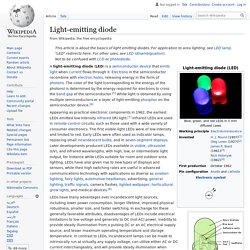

Casio beamer bij Beamershop24.nl. Blue Laser Pointer 1 Watt. Light-emitting diode. Parts of an LED.

Although unlabeled, the flat bottom surfaces of the anvil and post embedded inside the epoxy act as anchors, to prevent the conductors from being forcefully pulled out via mechanical strain or vibration. An LED is often small in area (less than 1 mm2) and integrated optical components may be used to shape its radiation pattern.[5] Appearing as practical electronic components in 1962,[6] the earliest LEDs emitted low-intensity infrared light.
Infrared LEDs are still frequently used as transmitting elements in remote-control circuits, such as those in remote controls for a wide variety of consumer electronics. The first visible-light LEDs were also of low intensity, and limited to red. Early LEDs were often used as indicator lamps for electronic devices, replacing small incandescent bulbs. Recent developments in LEDs permit them to be used in environmental and task lighting. History[edit] Discoveries and early devices[edit] Initial commercial development[edit] Diode. Closeup of a diode, showing the square-shaped semiconductor crystal (black object on left).

Structure of a vacuum tube diode. The filament may be bare, or more commonly (as shown here), embedded within and insulated from an enclosing cathode. Main functions[edit] However, diodes can have more complicated behavior than this simple on–off action, due to their nonlinear current-voltage characteristics. Semiconductor diodes begin conducting electricity only if a certain threshold voltage or cut-in voltage is present in the forward direction (a state in which the diode is said to be forward-biased). History[edit] Vacuum tube diodes[edit] Thomas Edison independently rediscovered the principle on February 13, 1880. Edison devised a circuit where his modified light bulb effectively replaced the resistor in a DC voltmeter. Solid-state diodes[edit] Etymology[edit] At the time of their invention, such devices were known as rectifiers. Rectifiers[edit] Thermionic diodes[edit] Diode vacuum tube construction. Green Laser Pointer, Blue, Red, Purple Lasers.
Laser diode. Top: a packaged laser diode shown with a penny for scale.

Bottom: the laser diode chip is removed from the above package and placed on the eye of a needle for scale. A laser diode with the case cut away. The actual laser diode chip is the small black chip at the front; a photodiode at the back is used to control output power. A laser diode, or LD, is an electrically pumped semiconductor laser in which the active medium is formed by a p-n junction of a semiconductor diode similar to that found in a light-emitting diode. The laser diode is the most common type of laser produced with a wide range of uses that include, but are not limited to, fiber optic communications, barcode readers, laser pointers, CD/DVD/Blu-ray reading and recording, laser printing, scanning and increasingly directional lighting sources.
Theory of operation[edit] Semi-conductor lasers (660 nm, 635 nm, 532 nm, 520 nm, 445 nm, 405 nm) A laser diode is electrically a P-i-n diode. Types[edit] Double heterostructure lasers[edit]